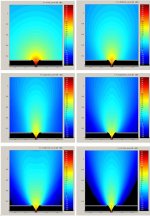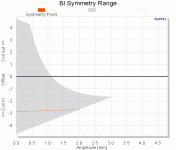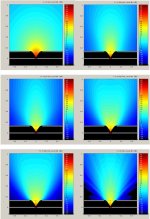Jmmlc said:Hello Earl,
Your work is not in question and most often the purpose of my interventions about your work or opinions, on french language forums wanted to be informative and eventually a source of discussion with their members, most of them don't read technical English.
So eventually we could discuss about :
- the inaudibility of compression drivers distortion (what pertinent
measurement should we perform to explain the differences we hear);
- the inaudibility of phase distortion (we did experiment with members of different forums on that...),
- the inaudibility of harmonic distortion at even large level (we did a group experiment on that on forum Audax...),
- the inaudibility of differences of sound between amplifiers (we did also many experiments at Mélaudia association),
- the useless of the loading of the loudspeaker by the horn...
- about loading largely not dependant on the horn profile...
- an irregular soundfield inside the horn doesnt mean bad sound at the listening position...
- directivity as the only important characteristics of a horn...
My opinions are those topics are well known and in print in most cases. I'll stand by them. Whats the criticism?
The overal area above and below zero must be equal over infinit time, and also dependent on driver characteristics. How this area distribution occurs depends on driver performance. Therefore, it is not necessary to have a large negative impulse immediately following the first positive one. Also bear in mind that if you use a Klippel system to do DC measurement, lots of drivers have DC. How fast the impulse goes to zero also depends on low frequency content decay.gedlee said:
...
This is completely wrong because there HAS TO BE a large negative impulse when there is a positive one because the average must be zero. And since the impulse response goes to zero very fast this average must be zero over the short term. And you say yourself that "The latter two impulses do not have this" and they must have!! I'm not going to argue this point with you its too fundamental.
Jmmlc said:Jêrôme,
Your hate of me is known here in France since long time, more than 15 years I guess. All along that time you refuted You refuted what I brought in Hifi about crossovers, quasi 2nd order bass-reflex, amplifiers and horns...
I don't know why your are so obsessed about me, may be a way to compensate your own lack of creativity.
Eevryone will be interested in the obsessional way you treated me as "an ennemy of science" on your blog:
"http://jipihorn.wordpress.com/2008/12/14/les-ennemis-de-la-science/"
Jean-Michel Le Cléac'h.
Mmmh, sounds like lack of arguments here... What I did or do on other locations is irrelevant in this place.
I think you overestimate a lot what you "invented" a bunch of years ago (what's new since 15 years ?) and most of your affirmations have no evidences (they can be true, nevertheless).
For your information, I don't care about you as a person (I don't know you personally) , only the methods and (lack of) argumentations you use on all the forum, mainly affirmations defined as evidences and systematic discredit of the "concurrence" (as you did with Earl). So, please, don't whine as a poor victim, it's a weak argumentum ad misericordiam. I've never named you as a "enemy of science", but that you use bad science when it suits you : hasty generalization !
I assume totally what I wrote on my blog since it's only facts that everybody can verify. You're welcome to make a right to reply and, of course, I'll make apologizes if I did something wrong.
But, let's go back to the topic : it's funny that you don't write the same way here about Earl works. Where are the criticisms ? What are your thoughts, conclusions and evidences ?
Are you afraid of what !?
Jipi.
soongsc said:
Also bear in mind that if you use a Klippel system to do DC measurement, lots of drivers have DC.
DC sound cannot be propagated even if the cone has a DC motion.
gedlee said:Which rules are being violated?
Read the first sentence of the post Earl.
We also don't like topics being brought here from other sites. As mentioned, if you have a problem, take it somewhere else. This is not a site for the spiteful nor whiners or ingrates. Stay on topic and remain polite regardless of the strength of your argument.
Thank you.
If you have further comments on this, feel free to email me.
When there is a DC component in the response, as measurable, and due to asymmetry of motor, suspension, etc. The transfer of energy into acoustic energy cannot be symmetric can it. Thus how can impulse response be totally symmetric?gedlee said:
DC sound cannot be propagated even if the cone has a DC motion.
Additionally, not data has been published under real measurement conditions, that impulse will be totally symmetric. It only exists under ideal conditions.
This is all incorrect.
There is never a DC component to the pressure response except under very idealistic conditions - an air tight room would exhibit a static pressure rise from a DC cone displacement, although such a pressure change would be miniscule and would disipate to zero unless the cabinet itself were air-tight. And, I know of no space for acoustic measurements that is air-tight - you would suffocate. Hence, no "real world" impulse response can have anything but an average level of zero.
There is never a DC component to the pressure response except under very idealistic conditions - an air tight room would exhibit a static pressure rise from a DC cone displacement, although such a pressure change would be miniscule and would disipate to zero unless the cabinet itself were air-tight. And, I know of no space for acoustic measurements that is air-tight - you would suffocate. Hence, no "real world" impulse response can have anything but an average level of zero.
Let me ask one fundamental question. If damping in a motor is not symmetric, how can it produce equal acoustic energy in both directions?gedlee said:This is all incorrect.
There is never a DC component to the pressure response except under very idealistic conditions - an air tight room would exhibit a static pressure rise from a DC cone displacement, although such a pressure change would be miniscule and would disipate to zero unless the cabinet itself were air-tight. And, I know of no space for acoustic measurements that is air-tight - you would suffocate. Hence, no "real world" impulse response can have anything but an average level of zero.
Additionally if the whole driver is in the room there can be not rise in static pressure. This is mainly because there is not change in total volume when the driver has DC cone displacement. You know better than that. If you are talking about an air tight speaker enclosure, then it's a different story. Don't mix things up now. We are all getting old...
Damping dissipates energy, why not?gedlee said:Old or not I am not making the mistakes here.
Asymmetric damping has nothing to do with what we are talking about. And I did say that the enclosure had to be air tight. Did you read my response?
Really, up to now there is still no calculated data that shows real world measurements would always yield symmetic impulse, no reference to theory that explains why it should be considering reasonable real world conditions.

This is a tweeter with response of 30KHz. This kind of impulse basically has the kind of first and inverted relationship. The real difference between the second impulse in the 2nd impulse of the 4 comparision is that the peak of the inverted impulse in this one is not larger than the first part. Thus better.
Attachments
soongsc said:... the peak of the inverted impulse in this one is not larger than the first part. Thus better.
That is completely ridiculous.
soongsc said:... no reference to theory that explains why it should be
I give up. What have I been saying all this time if it isn't an explaination of the "theory"?
No. Because if you actually do the calculation of the condition you described, it would be very dependent on driver performance. I have not seen any driver that would measure perfectly symmetric on a Klippel system. So the response cannot be symmetric. This is very different from idealistic math models.gedlee said:
I give up. What have I been saying all this time if it isn't an explaination of the "theory"?
Attachments
soongsc said:
No. Because if you actually do the calculation of the condition you described, it would be very dependent on driver performance. I have not seen any driver that would measure perfectly symmetric on a Klippel system. So the response cannot be symmetric. This is very different from idealistic math models.
I don't see how Bl symmetry has anything to do with it. The issue is the actual acoustic response to an impulse. The driver is at rest, there is an impulse with some overshoot and damping, then the driver is at rest again. The total response in integration about the rest position must be zero when integrated to infinity. Integrate over a finite time period, sure, it won't be zero, but that's not what matters.
Dave
soongsc said:So the response cannot be symmetric.
A wave can be asymmetric about zero and still average to zero.
- Home
- Loudspeakers
- Multi-Way
- Geddes on Waveguides




